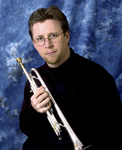
 |
Return to Tips for Trumpet |
by Dr.
Gary Wurtz |
Transposition is an inherent part of being a trumpet player. As orchestra members we rarely play a piece that does not require us to transpose, either because we don't own a trumpet in the specified key, or because we choose to play on a trumpet other than the one specified. The desire for a particular tone quality, better dynamic projection, more accessible high or low register, or even the opportunity to play in an easier key signature are some of the factors that we might use in determining which trumpet to use: B-flat, C, D, E-flat, cornet, flugelhorn or piccolo. In the chart below are the transpositions encountered in orchestral music in the various languages, and the transposition intervals from either B-flat or C trumpets.
|
|||||
| English | Italian | French | German | From Bb | From C |
| Trumpet | Tromba | Trompette | Trompete | ||
| C | DO | UT | C | up M2 | as written |
| D | RE | RE | D | up M3 | up M2 |
| E b | MI b | MI b | Es | up P4 | up m3 |
| E | MI | MI | E | up tritone | up M3 |
| F | FA | FA | F | up P5 | up P4 |
| G | SOL | SOL | G | up M6 | up P5 |
| A b | LA b | La b | As | down M2 | down M3 |
| A | LA | LA | A | down m2 | down m3 |
| B b | SI b | SI b | B | as written | down M2 |
| B | SI | SI | H | up m2 | down m2 |
| major | maggiore | majeur | Dur | ||
| minor | minore | mineur | Moll | ||
| flat | bemolle | bémol | ces | ||
| sharp | diesis | dièse cis | |||
Transposition Specifically for Band Directors
The trumpet world is full of great players and teachers, and I humbly bow before them all. Generally speaking, those of us who post articles on the Texas School Music Project web site think of them as geared for band directors looking for helpful hints for themselves or their students. For that reason I want to address transposition from the position of the band director whose major instrument is the trumpet. First of all, I think it is a great idea for band directors to play for their students. Some of the band directors I have respected the most have been great players who demonstrated for the students regularly. In order to play the line for every instrument on the band score, the following transpositions must be employed when using a B-flat trumpet:
- For piccolos, flutes and oboes in C: up a M2.
- For clarinets, bass clarinets, and tenor saxes in B-flat: play as written.
- For E-flat alto saxes, bari saxes, and E-flat clarinets: play up P4 (or as bass clef up a step, add 1 flat).
- For horn and English horn in F: play up a P5.
- For all bass clef instruments: play bass clef up a step, add one flat.
Notice that if one can master the transposition of bass clef up a step, he or she can use that to transpose for the majority of the band instruments (E-flat clarinet, alto sax, bari sax, bassoon, trombone, euphonium, and tuba).
| The Texas School Music Project is a source for ideas and information concerning pedagogical practices in the music classroom or rehearsal hall. The TSMP is a service provided to all music specialists by the faculty of the School of Music at Stephen F. Austin State University. For questions about this site contact [email protected]. Copyright © 2002-2019, The
School of Music at Stephen F. Austin State University |